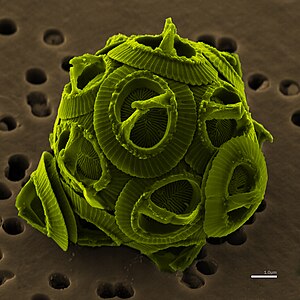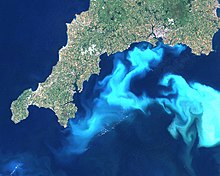Haptophyta
| Haptophyta | ||||||||
|---|---|---|---|---|---|---|---|---|

False color image of Gephyrocapsa oceanica , a representative of the subgroup Coccolithales |
||||||||
| Systematics | ||||||||
|
||||||||
| Scientific name | ||||||||
| Haptophyta | ||||||||
| DJ Hibberd , 1976 |
The Haptophyta (formerly also called Prymnesiophyta ) are predominantly marine - planktonically living, complex single-celled algae .
properties
The yellow, yellow-brown or brown chloroplasts contain chlorophyll a and c, β- carotene and xanthophylls . Chrysolaminarin , oil and rarely paramylon (also known as paramylum) are deposited as reserve materials . The chloroplasts are located in a fold of the endoplasmic reticulum . The chloroplasts resemble those of the heteroconts , but the rest of the cell structure differs from these, which is why the haptophyta are now systematically separated from the heteroconta.
Flagellated cells have two flagella usually equally long or only slightly different in length ( isocontal flagellation). The flagella are not covered with cilia as in the heteroconta, but with submicroscopic scales or knots. In contrast to the hetero accounts, the flagella also do not have a swollen base (flagella swelling).
In addition to the flagella, every cell has a haptonema . It is a thread-like appendage that is used for attachment. The structure is superficially similar to that of a flagellum, but in the cross section there are 6 or 7 crescent-shaped microtubules .
The outside of the cells is covered with scales made of polysaccharides (mostly cellulose ), which are formed in Golgi vesicles and then deposited on the cell surface. In the order Coccolithales, the outer scales are calcified and are called coccoliths . The function of the coccoliths is so far only insufficiently known. It is assumed u. a. Eating protection, buoyancy regulation, light supply or calcification to support photosynthesis . Sometimes there is also an eye spot , as in the gold algae and the Euglenozoa .
Although representatives of the monadal level of organization predominate, there are also capsal, coccal and trichal representatives. Some species have a heteromorphic generation change , i. H. the different generations can be clearly distinguished from the outside. In these calcareous algae, a diploid generation (with a double set of chromosomes ), in which the algae have flagella and live in plankton , alternates with a haploid stage (with a single set of chromosomes), in which they are benthic , i.e. H. on the ocean floor, live.
Occurrence
Only a few species live in fresh water, most of the species live planktonic in the sea. They can occur in very large quantities and form a significant part of marine plankton. The planktonic haptophytes thus play an important role as primary producers in the sea. Some species are cosmopolitan , but the majority occurs in the seas of temperate latitudes . The cosmopolitan Coccolithales species Emiliania huxleyi occurs in particularly large quantities . It is one of the most important producers of biogenic calcium carbonate and can cause large-scale algal blooms .
Haptophytes also appear as symbionts, such as zooxanthellae in acantharia .
Systematics
Its systematic position was unclear for a long time; it has now been largely revised and clarified using molecular biological methods. The department is divided into the following classes:
- Coccolithophyceae (650 species)
- Haptophyta incertae sedis (61 species)
- Pavlovophyceae (15 species)
literature
- N. Daugbjerg, RA Andersen: Phylogenetic analysis of the rbcL sequences from haptophytes and heterokont algae suggest their chloroplasts are unrelated. In: Mol. Biol. Evol. 1997, 14, 1242-1251.
- A. Houdan, A. Bonnard, J. Fresnel, S. Fouchard, C. Billard and I. Probert: Toxicity of coastal coccolithophores (Prymnesiophyceae, Haptophyta). In: J. Plankton Res. 26. 2004, 875-883.
- Christian van den Hoek, Hans M. Jahns, David G. Mann: Algae . 3. Edition. Thieme, Stuttgart 1993, ISBN 3-13-551103-0
- Guiry, MD & Guiry, GM 2017. AlgaeBase . World-wide electronic publication, National University of Ireland, Galway. http://www.algaebase.org; searched on August 25, 2017.
proof
- ↑ Colette Febvre, Jean Febvre, Anthony Michaels: Acantharia In: John J. Lee, GF Leedale, P. Bradbury (Eds.): An Illustrated Guide to the Protozoa . tape 2 . Allen, Lawrence 2000, ISBN 1-891276-23-9 , pp. 785 .
- ^ Cavalier-Smith, T. (1986). The kingdom Chromista: origin and systematics. In: Progress in phycological research. Vol. 4 . (Round, FE & Chapman, DJ Eds), pp. 309-347. Bristol: Bipress Ltd.
- ↑ Fujiwara, S., Tsuzuki, M., Kawachi, M., Minaka, N. & Inouye, I. (2001). Molecular phylogeny of the Haptophyta based on the rbc L gene and sequence variation in the spacer region of the RUBISCO operon. Journal of Phycology 37: 121-129.
- ↑ Silva, PC, Throndsen, J. & Eikrem, W. (2007). Revisiting the nomenclature of haptophytes (Commentary). Phycologia 46: 471-475.
